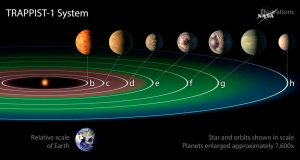
NASA astronomers say they have discovered seven Earth-size planets around a nearby star, some or all of which could harbour water and possibly life.
The exoplanets were spotted around a small, faint star in the constellation of Aquarius called called Trappist-1, less than 40 light-years from Earth, or 235 trillion miles away.
Three of the planets found appear to host surface temperatures capable of sustaining liquid water and, therefore, oceans.

BYPASS THE CENSORS
Sign up to get unfiltered news delivered straight to your inbox.
You can unsubscribe any time. By subscribing you agree to our Terms of Use
The discovery has raised hopes that the hunt for alien life beyond the solar system could start much sooner than previously thought.
The TRAPPIST-1 star & 7 Earth-sized planets orbiting it, are relatively close to us; located ~40 light-years away: https://t.co/QS80AnZ2Jgpic.twitter.com/GiKAFXyNvo
— NASA (@NASA) February 22, 2017
The Guardian reports:
It is the first time that so many Earth-sized planets have been found in orbit around the same star, an unexpected haul that suggests the Milky Way may be teeming with worlds that, in size and firmness underfoot at least, resemble our own rocky home.
The planets closely circle a dwarf star named Trappist-1, which at 39 light years away makes the system a prime candidate to search for signs of life. Only marginally larger than Jupiter, the star shines with a feeble light about 2,000 times fainter than our sun.

“The star is so small and cold that the seven planets are temperate, which means that they could have some liquid water and maybe life, by extension, on the surface,” said Michaël Gillon, an astrophysicist at the University of Liège in Belgium. Details of the work are reported in Nature.
A newly discovered solar system just 39 light years from earth contains planets which could contain liquid water
Trappist-1 is a system containing seven planets comparable to Earth. They orbit a small star called an utra-cool dwarf. The distance of the planets from the star means that liquid water could be found on their surfaces.
While the planets have Earth-like dimensions, their sizes ranging from 25% smaller to 10% larger, they could not be more different in other features. Most striking is how compact the planet’s orbits are. Mercury, the innermost planet in the solar system, is six times farther from the sun than the outermost seventh planet is from Trappist-1.
Any life that gained a foothold and the capacity to look up would have a remarkable view from a Trappist-1 world. From the fifth planet, considered the most habitable, the salmon-pink star would loom 10 times larger than the sun in our sky. The other planets would soar overhead as their orbits required, appearing up to twice the size of the moon as seen from Earth. “It would be a beautiful show,” said Amaury Triaud at the Institute of Astronomy at Cambridge University
The researchers hope to know whether there is life on the planets “within a decade,” Amaury added. “I think we’ve made a crucial step in finding out if there’s life out there,” he said. “If life managed to thrive and releases gases in a similar way as on Earth, we will know.”
Take a 360° tour of TRAPPIST-1d, one of the Earth-sized plants in the newly discovered system ~40 light-years away: https://t.co/5mMKpRPcoc pic.twitter.com/RRuPiOleOe
— NASA (@NASA) February 22, 2017


lol, lol, lol, stop it I have stomach cramps.
NASA don’t know jack about what they are looking at.